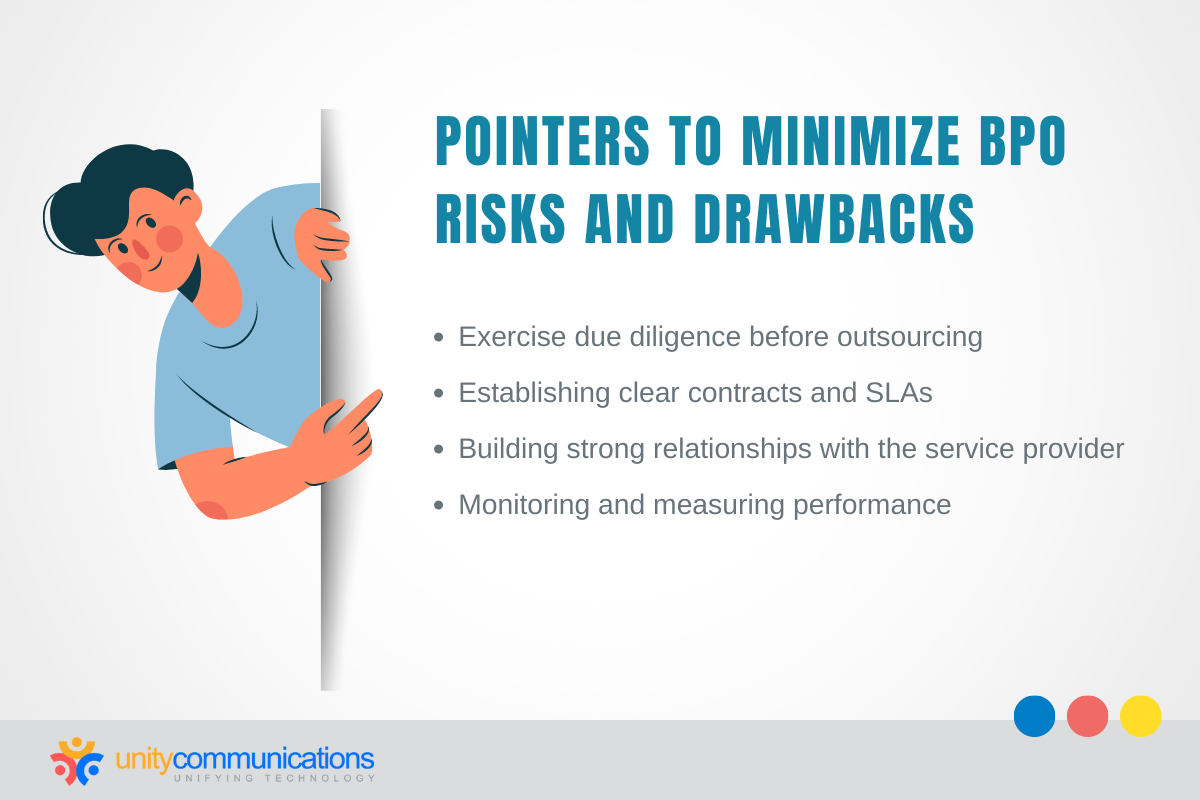Table of Contents
To succeed in business, you need partners. Among them are business process outsourcing (BPO) companies. These service providers can help you meet your requirements and achieve your goals. They can enhance the company’s output, efficiency, value, and revenue.
Every venture has potential issues, however. So do the disadvantages of outsourcing outweigh its benefits? How can you minimize these challenges to capitalize on this approach?
This article discusses BPO’s common risks, drawbacks, and mitigation strategies. Stay on this page to learn about a real-life case of outsourcing gone wrong.
Introduction to BPO and Its Benefits
Before explaining the risks and drawbacks of BPO, we must answer this question: What is BPO?
BPO is an approach in which you outsource tasks or delegate some of your operations to a third-party provider. This vendor ensures high-quality outsourced processes by following a service-level agreement (SLA) that contains well-defined and measurable parameters known as key performance indicators (KPIs).
Some of the main benefits of BPO include:
- Core business focus. Hiring an outsourcing company to manage back-office operations lets you focus on income-generating activities, such as developing and introducing the latest product or service and launching major marketing or sales programs. Outsourcing can help you concentrate on core processes that sharpen your business edge.
- Overall cost reduction. Subcontracting converts the costs of your business operations into variable expenses. Doing so reduces ongoing costs and capital expenditures, resulting in significant cost savings. You can then use the extra funds for other ventures.
- Customer satisfaction at greater levels. The third-party team specializes in delivering consistently excellent customer service and experience. Higher consumer satisfaction leads to stronger loyalty to your product or service, increasing repeat business.
Common BPO Risks and Drawbacks

Consider the following BPO risks and drawbacks that organizations might encounter in the long term:
Security Risks
Security issues are one of the disadvantages of business process outsourcing. Delegating a BPO project involves disclosing confidential customer, client, and corporate data to an independent group.
Third-party vendors access critical information such as bank accounts, credit card numbers, insurance and investment details, passwords, and addresses. Data breaches or unauthorized network access can occur through vulnerable or unauthenticated applications, files, and other data.
Communication Risks
The remote working setup of third-party teams when using BPO services can pose communication challenges. Performing tasks within your physical office typically facilitates quicker and more convenient interaction and collaboration compared to a virtual workspace.
BPO vendors offering offshoring or nearshoring services are often far from your primary office location. This physical distance between your organization and the service provider can delay addressing urgent or emergency issues.
Cost Risks
Hidden costs represent one of the potential drawbacks within the BPO industry. Certain BPO companies may levy additional fees, undisclosed pricing structures, and unforeseen charges. These hidden expenses encompass various aspects, including business interruptions, employee terminations, supplementary workforce requirements, job relocations, and the need for legal assistance beyond the initial agreement.
Sometimes, service providers may demand a percentage of the revenue, resulting in variable rates tied to their sales performance. Initiation fees and expenses associated with report generation and statement printing can also fall under concealed charges.
Quality Risks
Inadequate or subpar service delivery represents a significant concern within the realm of BPO.
Selecting an inappropriate BPO provider can lead to quality-related issues. Opting for a partner solely based on cost considerations might not necessarily align with your goals, requirements, or industry-specific expertise needs.
Furthermore, certain BPO firms may operate a single support team concurrently servicing multiple clients, sometimes without your consent. This approach can force team members to split their expertise, time, and crucial resources across clients in order to fulfill all assigned responsibilities. Such a setup may ultimately compromise the quality of the service provided.
Control Risks
Inadequate or subpar service delivery represents a significant concern within the realm of BPO.
Selecting an inappropriate BPO provider can lead to quality-related issues. Opting for a partner solely based on cost considerations might not necessarily align with your goals, requirements, or industry-specific expertise needs.
Strategies for Mitigating BPO Risks and Drawbacks

Consider these pointers to minimize outsourcing challenges:
Conducting Due Diligence
Exercise due diligence before outsourcing to ensure a partnership founded on responsibility, openness, and confidence. Examining the service provider’s dependability helps you analyze the potential BPO risks and drawbacks so that you can develop measures to mitigate them.
When performing due diligence, follow these helpful tips:
- Seek professionals with backgrounds and knowledge of outsourcing that meet your needs. So if you plan to leverage artificial intelligence (AI), look for an expert in AI and BPO.
- Make a surprise visit to your potential partner, if possible, to inspect its actual working environment and facilities.
- Research the prospective partner’s suppliers and clients to determine its reputation, service quality, and relations with third-party groups.
Establishing Clear Contracts and SLAs
Lay out a straightforward contract and an SLA before delegating processes to minimize BPO risks and drawbacks. Obtain the third-party provider’s full-service records and experience to develop a solid and balanced outsourcing agreement. This information will assist you in assessing the level of service they can provide.
Let the service provider evaluate your requirements and expectations, identify your challenges, and provide a starting point to measure service level enhancements.
Establish a framework for the SLA contract. Brainstorm, scrutinize, and bargain over every section of the written agreement if necessary. Then, execute the terms and conditions properly.
Building Strong Relationships With the Service Provider
Form and maintain a solid working relationship with the third-party provider to reduce BPO’s risks and drawbacks. Below are some points to help you maximize your outsourcing collaboration:
- Adopt achievable targets. Goals and expectations must be optimistic and realistic simultaneously. Know your partner’s competence and limitations to help you set reasonable requests and objectives.
- Determine a regulatory structure. Build a management system with the BPO provider to include all aspects of outsourced processes. This helps improve collaboration, allowing you and your partner to make better and quicker collective decisions.
- Emphasize transparent communication. Establish open communication with the BPO partner by conducting regular online meetings and implementing multichannel capabilities to remove communication barriers.
Monitoring and Measuring Performance
Evaluate whether your organization gets adequate value from outsourcing to manage its downsides. Track and gauge output and efficiency with two standard methods:
- Quantitative. Net promoter scores, average response time, and customer satisfaction scores are metrics used to assess performance.
- Qualitative. Soft skills relate to the agents’ expertise and communication abilities.
Hold frequent discussions with the team supervisor to improve surveillance. Check whether the team meets KPIs to ensure goals are within targets and expectations.
Case Study of BPO’s Risks and Drawbacks

PatientDox was a newly formed business that offered healthcare providers software-as-a-service (SaaS) solutions. The platform featured encrypted messaging, appointment scheduling, and patient information resources to increase patient interaction, satisfaction, and experience.
The startup was off to a promising start but needed more software and technical experts, so outsourcing was the option to address this inadequacy. However, its outsourcing strategy did more harm than good.
Most of its outsourcing costs were spent on product development instead of patient service enhancements, draining the company’s funds and slowing operations accordingly. Additionally, the third-party teams were involved in different projects at once. The lack of prioritization and customer support improvement led to the company’s financial instability.
Weak outsourcing strategies, an inability to respond to market changes, and tight industry competition led to PatientDox’s business closure.
The Bottom Line
Now, you should know more about potential issues and challenges connected to outsourcing. Knowing the pros and cons aids you in making informed decisions about whether outsourcing is an ideal strategy.
Service providers can help you save time, effort, and money while enabling you to concentrate on what you do best as a business owner or corporate executive. Exercise precaution, conduct research, and choose the ideal BPO partner for successful outsourcing.
Let’s connect if you want to learn more about BPO risks and drawbacks.




